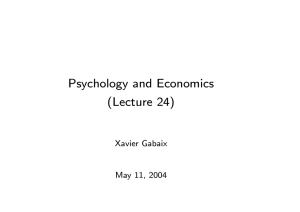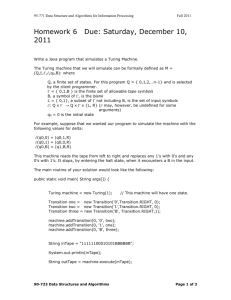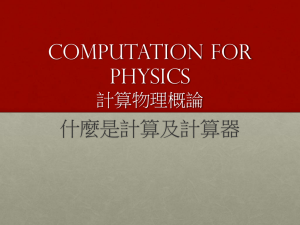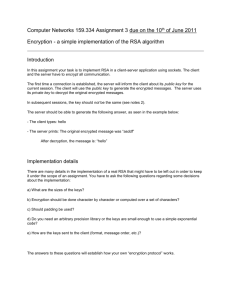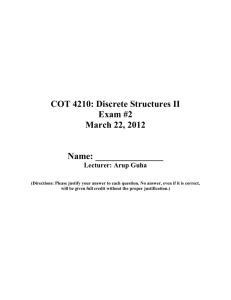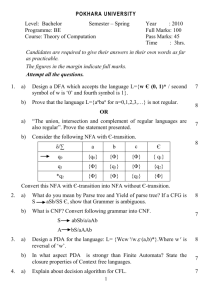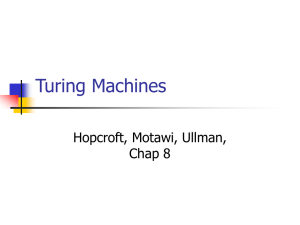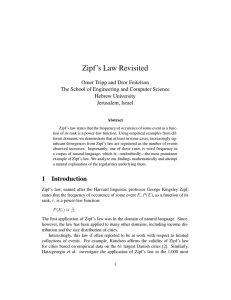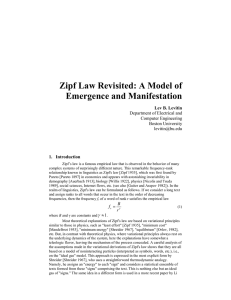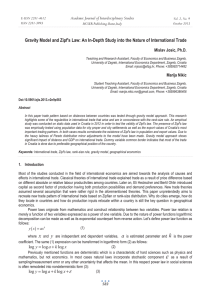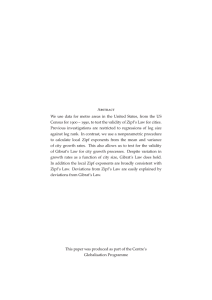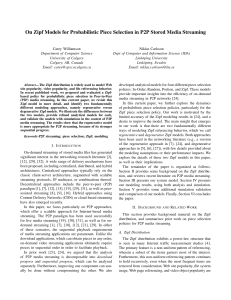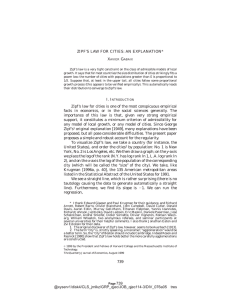projects - Richard G. Clegg
advertisement
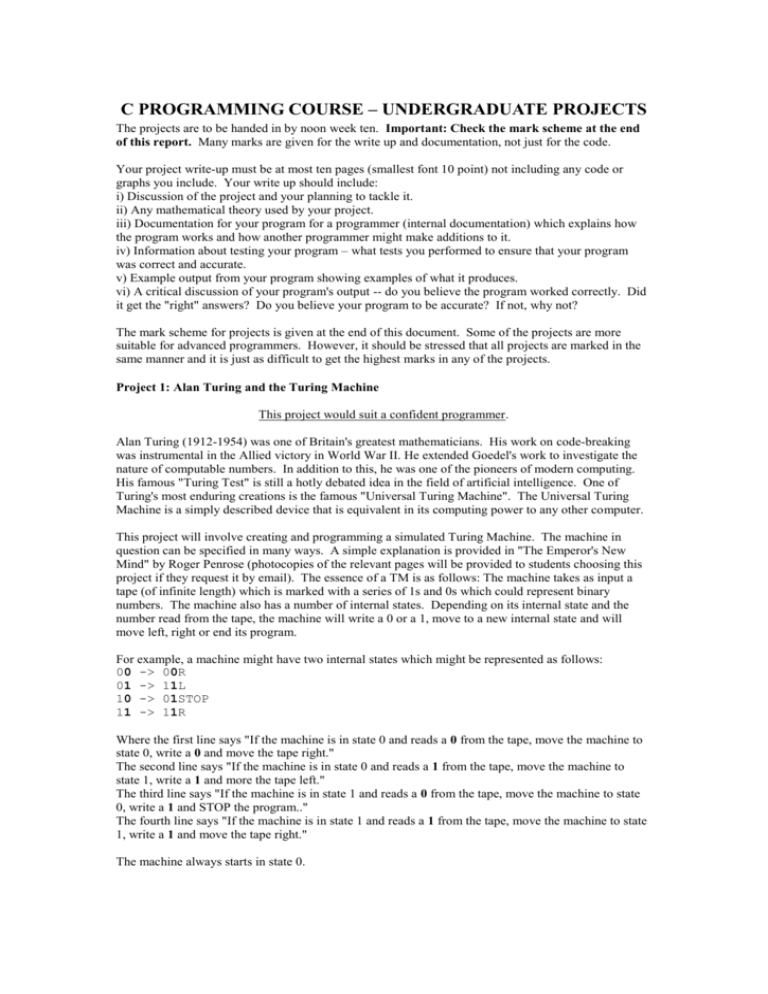
C PROGRAMMING COURSE – UNDERGRADUATE PROJECTS The projects are to be handed in by noon week ten. Important: Check the mark scheme at the end of this report. Many marks are given for the write up and documentation, not just for the code. Your project write-up must be at most ten pages (smallest font 10 point) not including any code or graphs you include. Your write up should include: i) Discussion of the project and your planning to tackle it. ii) Any mathematical theory used by your project. iii) Documentation for your program for a programmer (internal documentation) which explains how the program works and how another programmer might make additions to it. iv) Information about testing your program – what tests you performed to ensure that your program was correct and accurate. v) Example output from your program showing examples of what it produces. vi) A critical discussion of your program's output -- do you believe the program worked correctly. Did it get the "right" answers? Do you believe your program to be accurate? If not, why not? The mark scheme for projects is given at the end of this document. Some of the projects are more suitable for advanced programmers. However, it should be stressed that all projects are marked in the same manner and it is just as difficult to get the highest marks in any of the projects. Project 1: Alan Turing and the Turing Machine This project would suit a confident programmer. Alan Turing (1912-1954) was one of Britain's greatest mathematicians. His work on code-breaking was instrumental in the Allied victory in World War II. He extended Goedel's work to investigate the nature of computable numbers. In addition to this, he was one of the pioneers of modern computing. His famous "Turing Test" is still a hotly debated idea in the field of artificial intelligence. One of Turing's most enduring creations is the famous "Universal Turing Machine". The Universal Turing Machine is a simply described device that is equivalent in its computing power to any other computer. This project will involve creating and programming a simulated Turing Machine. The machine in question can be specified in many ways. A simple explanation is provided in "The Emperor's New Mind" by Roger Penrose (photocopies of the relevant pages will be provided to students choosing this project if they request it by email). The essence of a TM is as follows: The machine takes as input a tape (of infinite length) which is marked with a series of 1s and 0s which could represent binary numbers. The machine also has a number of internal states. Depending on its internal state and the number read from the tape, the machine will write a 0 or a 1, move to a new internal state and will move left, right or end its program. For example, a machine might have two internal states which might be represented as follows: 00 -> 00R 01 -> 11L 10 -> 01STOP 11 -> 11R Where the first line says "If the machine is in state 0 and reads a 0 from the tape, move the machine to state 0, write a 0 and move the tape right." The second line says "If the machine is in state 0 and reads a 1 from the tape, move the machine to state 1, write a 1 and more the tape left." The third line says "If the machine is in state 1 and reads a 0 from the tape, move the machine to state 0, write a 1 and STOP the program.." The fourth line says "If the machine is in state 1 and reads a 1 from the tape, move the machine to state 1, write a 1 and move the tape right." The machine always starts in state 0. The simple machine defined here takes a unary number (defined by a number of 1's – e.g. 1111 is unary 4) as input on the tape and adds one to it. A student doing this project would write a program to read a file which defines the machine's internal states (in a similar form to the machine defined above) and another file which defines the initial marked tape. The program will then simulate the action of the Turing Machine and eventually produce some output tape (or the machine may crash – like any "computer" a Turing Machine may get into an infinite loop). Having designed a simulated Turing Machine, the student will then test it with simple programs. Typical things which would be included in a good project: 1) A good description of the TM and how it works. 2) Demonstration output of the simulated TM running simple programs. 3) Demonstration of what happens if the TM runs into problems. Project 2: The Three Body Problem This project would suit a beginning programmer. The famous "three body problem" refers to the problem of calculating the paths of three bodies acting under gravity. Johannes Kepler (1571-1630) discovered three laws which governed planetary motion. Issac Newton (1642-1727) generalised Kepler's laws in his laws of motion and law of gravitation. Newton was then able to derive the motion of a planet orbiting a sun. It was thought that, in time, it would prove a simple matter to extend Newton's work to cover the orbital motion of three interacting bodies. However, this proved not to be the case and the three body problem remains one of the great unsolved mathematical problems. In researching the problem, Jules Henri Poincare (1854-1912) became the first person to discover a deterministic chaotic system – the solar system as described by Newtonian mechanics. For his publication "On the problem of Three Bodies and the Equations of Equilibrium" Poincare won a mathematical prize awarded by King Oscar II of Sweden to anyone who could answer the question "Is the Solar System Stable?". In this project, the student will "solve" the three body problem. In this case the "solution" is to simulate a two dimensional planetary system under Newtonian gravity with at least three bodies. (For example, the Earth, Sun, Moon system). The simplest possible simulation method is as follows: 1) Select a small "time step" to be used for simulation. 2) Specify masses and initial positions and velocities for each of the three bodies. 3) Move each of the bodies by a small amount according to its velocity and the time step. 4) Change the velocity of each of the bodies by a small amount according to its acceleration and the time step. 5) Goto 3. By printing the positions of the bodies in each time step, we can have a graphical display of how the system might evolve. A good project would include: 1) Background to the probelm and mathematical analysis. 2) Simulation of the earth/sun/moon system in two dimensions – if the orbit of the earth and the moon are of the right length then this proves it is working. This is a good place to start and to check your code really works. Your project might also include any of the following 3) Clever use of structs to reduce the number of variables being passed around. 4) Simulation of a whole solar system in three dimensions. 5) Simulation of other multiple body systems – perhaps exhibiting chaotic motion. 6) Sensitivity analysis. Project 3: Zipf's Law This project would suit a beginning programmer George Kingsley Zipf (1902-1950) was an American linguist who discovered Zipf's law. Zipf's law relates to the frequency of occurrence of English words. His work is published in "Selected Studies On The Principle Of Relative Frequency In Language" (1979) which is available from the library. More information on Zipf's law is available on the web site: http://linkage.rockefeller.edu/wli/zipf/. This is related to the topic known as “heavy tailled distributions” to statisticians. Zipf's law states that, in any text, if we take the individual words and rank them in order of frequency, the frequency of occurrence of the word (P i) is a function of its rank i. Pi ~ 1/ia The first part of this project is reading to investigate Zipf's law and data sets other than English texts for which it might apply. Some electronic versions of books can be found on http://www.promo.net/pg/ - start your work with small texts. In this project, the student will create a program which will: i) Read in a text from a file. As we read the file, break the file into words. ii) Count the number of occurrences of each word. iii) Rank the words in order of frequency. iv) Plot word frequency versus word rank (using Maple or excel for example) and compare the results with Zipf's law. There are a number of ways in which we might choose to implement this. A simple way is, as follows: a) Define a large array of strings which will contain all our words. Blank them all. b) Define an array which is the same size to count the number of occurrences. c) Set a counter to the number of words found so far (0). d) Open a file and move along it looking for words. e) Every time we find a new word: i) Move along the array from 0 to the number of words found so far comparing it with the other words to check if it is new. ii) If the word is new then enter it into our array of strings at the position indicated by our counter for the number of words. Set the appropriate element of our occurrence array to 1. Increment the number of words found so far. iii) If the word is not new then increment the appropriate element of our occurrence array by 1. f) Print the final total of words and number of occurrences. g) Use the Excel or some other package to sort the list into order To get more marks, however, students could implement more advanced sorting and searching techniques once this more basic version is written. This version of the code is extremely inefficient and slow and will only be suitable for small texts. A more advanced student could implement their own sorting routine to sort the words into order. Bubble sort is an easy to implement sorting algorithm. Quick sort is a relatively efficient sorting algorithm. Similarly, this method of putting words into an array is inefficient. A good programmer would implement a more efficient method such as (vaguely in order of efficiency) a linked list, a skip list or a binary tree. These search and sort methods will be described in a later lecture and can also be found in volume 3 of Knuth's "The Art of Computer Programming" and the excellent web site http://epaperpress.com/sortsearch/. You may freely adapt code found on the web site to your purposes but please credit it if you do.. A further possible avenue for exploration is finding data sets other than word frequencies which obey Zipf's law. A number of other phenomena are believed to obey this law. A good project would include: 1) Discussion of Zipf’s law and places where it occurs. 2) Graphs producted from texts showing whether Zipf’s law holds for that text. You might also include: 3) More than one sorting and searching algorithms to compare efficiency. 4) Zipf’s law on different data sets. Project 4: Cryptography This project is very flexible and would suit any level of programmer Modern cryptography relies on computers to encode and decode documents. For example, modern web browsers (e.g. Netscape) have built in encryption schemes to allow for the safe transmission over the net of sensitive details such as credit card numbers. This project looks at several encryption schemes, compares their strengths and weaknesses and may go on to look at ways of breaking such schemes. Your write-up should include details of how the algorithms you use work. One of the oldest known cryptosystems is the Caesar shift cipher. This is simply the code where A become B, B becomes C, C becomes D etc. This can be considered as addition modulo 26 on an alphabet. This is a good starting point for beginning programmers to get a simple encoding and decoding algorithm working. The RSA algorithm was developed by Rivest, Shamir and Alderman. It uses basic number theoretic ideas and relies for its security upon the difficulty of factoring large primes. The user chooses two large primes. Both of these are needed for decryption, but only the product of the two is needed for encryption. It’s described nicely in Burton’s book (see below). DES is the US Government’s data encryption standard. It is a “product cipher” i.e. it takes several operations such as substitution, transposition, modular addition/multiplication and linear transformations and applies these to a block of data at a time. It then moves on to the next block and repeats until the end is reached. Its security is hard to judge. It depends crucially on the length of the key used to describe which operations are applied in which order to the data. Commonly used key lengths are 64 or 128 bytes. What this project could involve Implement the Caesar shift or some other very simple cipher. Implement RSA using a very small key length – note that integers overflow very easily so you can only do a “toy” implementation encoding one character at a time with very low primes. Implement other, more exotic systems of encoding such as Vignere or even an Enigma machine. Break RSA via brute force searching. Consider how to make your search as efficient as possible. Look at how public key cryptography can be used to digitally “sign” a message. Use a high precision library such as GMP http://www.swox.com/gmp/ to implement "real" RSA encryption (difficult). Some extra references Simon Singh "The Code Book" (an easy to read introduction which includes simplified mathematical explanations) The sci.crypt FAQ. http://www.faqs.org/faqs/cryptography-faq/ Ronald Rivest’s homepage. http://theory.lcs.mit.edu/~rivest/crypto-security.html Burton, D. “Elementary Number Theory”. Recent editions of this book contain good discussions on the RSA and Knapsack algorithms (you should look at this for your write up to explain the algorithms). A good project would include: 1) A discussion of all algorithms for cryptographic methods you use and mathematical proofs where appropriate. 2) One or more encryption and decryption algorithms. 3) Output showing your code encrypting and decrypting a trial text. (If you are not a confident programmer, start with the Caesar cypher so you know that you have something working though the Caesar shift is so trivial that you should try to do more than just this.) You might also include: 4) Methods for breaking your encryption. 5) More than one encryption method. 6) Analysis of any weakness in your encryption method. Project Mark Scheme 30 Marks – Content of Code: Did the code achieve what it set out to do? Were the algorithms used suitable? The more complex the task your code achieves the better your mark in this section. 10 Marks – Style of Code: Was your code well-written and in a good style? Was it clearly laid out and indented consistently? (Look at example code in worked examples on the web-site for well-laid out code). 20 Marks – Write up: This is for the general content of your write up and includes your explanation of what your project was about and your presentation of its results. Did you clearly explain the problem solved by your project? Did you include any relevant mathematics? For example: in the Cryptography project a clear explanation of RSA would be critical to getting top marks here. In the Zipf's Law project, proving that your results verify (or disprove) Zipf's law would be important. 15 Marks – Documentation: Was your code documented well? (This includes comments in the code but is mainly the documentation within your write up). Have you shown evidence of testing the code? 5 Marks – Presentation: Was your project clearly and neatly presented? Was it easy to understand and well laid out. The remaining 20 marks (to make 100) will be taken from your coursework.

